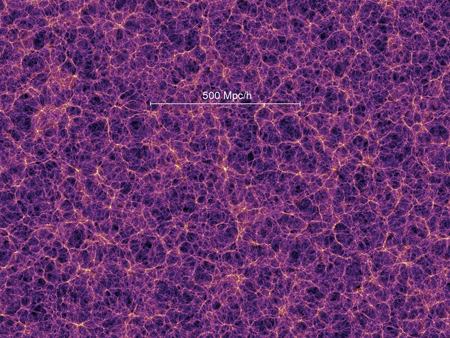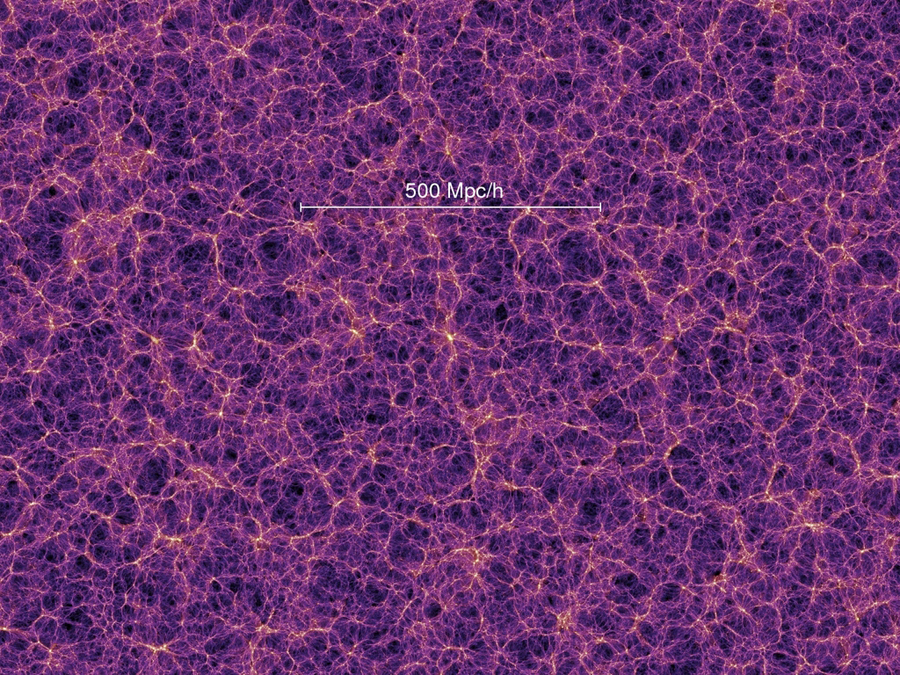Cosmic smoothness
The universe is expected to be very nearly homogeneous in density on large scales. In Physical Review Letters, Shaun Thomas and colleagues from University College London analyze measurements of the density of galaxies on the largest spatial scales so far—billions of light years—and find that the universe is less smooth than expected [1]. If it holds up, this result will have important implications for our understanding of dark matter, dark energy, and perhaps gravity itself.
In the current standard cosmological model, the average mass-energy density of the observable universe consists of normal matter (most of which is hydrogen and helium), dark matter, and dark energy. The dark energy is assumed to be uniform, but the normal and dark matter are not. The balance between matter and dark energy determines both how the universe expands and how regions of unusually high or low matter density evolve with time.
The same cosmological model predicts the statistics of the nonuniform structure and their dependence on spatial scale. On scales that are small by cosmological standards, fluctuations in the matter density are comparable to its mean, in agreement with what is seen: matter is clumped into galaxies, clusters of galaxies, and filaments of the “cosmic web.” On larger scales, however, the contrast of the structures compared to the mean density decreases. On the largest cosmological scales, these density fluctuations are small in amplitude compared to the average density of the universe and so are well described by linear perturbation theory (see simulation results in Fig. 1). Moreover, these perturbations can be calibrated at early times directly from the cosmic microwave background (CMB), a snapshot of the universe from when it was only years old. Despite the fact that only of the Universe is well understood, this model is an excellent fit to data spanning a wide range of spatial scales as the fluctuations evolved from the time of the CMB to the present age of the universe, some billion years. On the largest scales, dark energy drives accelerated expansion of the universe. Because this aspect of the standard model is least understood, it is important to test it on these scales.
Thomas et al. use publicly-released catalogs from the Sloan Digital Sky Survey to select more than galaxies whose observed colors indicate a significant redshift and are therefore presumed to be at large cosmological distances. They use the redshift of the galaxies, combined with their observed positions on the sky, to create a rough three-dimensional map of the galaxies in space and to assess the homogeneity on scales of a couple of billion light years. One complication is that Thomas et al. measure the density of galaxies, not the density of all matter, but we expect that fluctuations of these two densities about their means to be proportional; the constant of proportionality can be calibrated by observations on smaller scales. Indeed, on small scales the galaxy data are in good agreement with the standard model. On the largest scales, the fluctuations in galaxy density are expected to be of order a percent of the mean density, but Thomas et al. find fluctuations double this prediction. This result then suggests that the universe is less homogeneous than expected.
This result is not entirely new: previous studies based on subsets of the data studied by Thomas et al. showed the same effect, albeit with a lower statistical significance [2]. In addition, there are other ways of probing the large-scale mass distribution. For example, inhomogeneities in the mass distribution lead to inhomogeneities in the local rate of expansion. Some studies have suggested that, on very large scales, this expansion too is less homogeneous than the model predictions [3].
Another way to probe the mass distribution is the so-called Integrated Sachs-Wolfe effect. Photons from the CMB that travel to us through a region of higher mass density acquire a gravitational blueshift as they fall in, and a redshift as they emerge. If the depth of the potential well changes during the photons’ transit, these two effects will not cancel and the photons will acquire a net frequency shift. One recent study [4] has found an excess signal, again suggesting that the universe may be less uniform than expected on very large scales.
If the inhomogeneity is confirmed, the implications for the standard model would be severe, and might entail a reconsideration of the nature of dark matter and dark energy, or even of the applicability of general relativity on cosmological scales. But given the resounding success of the standard model to date, we should be hesitant before discarding it, and instead consider alternative explanations.
The measurements of galaxy clustering are challenging because the signal—a percent-level fluctuation—is small, so systematic effects must be extremely well controlled. In particular, light from distant galaxies passes through our own Milky Way galaxy on the way to the telescope. Dust clouds in the outer parts of the Milky Way may absorb or scatter the light of distant galaxies, making some of them appear too dim to measure. These effects are known, but may not be perfectly calibrated. Faint stars in the outskirts of the Milky Way have two subtle effects on the data: they can be mistaken for distant galaxies, or their presence can hide the existence of distant galaxies that are nearby in the sky. If any of these effects varies across the sky, the variation could be mistaken for a variation in intrinsic distribution of background galaxies. Although Thomas et al. examined some of these issues, a recent preprint [5] claims that this “masking” effect of stars has significantly contaminated their results.
Future large-scale surveys [6] will produce an avalanche of data. These surveys will allow the methods employed by Thomas et al. and others to be extended to still larger scales. Of course, the challenge for these future surveys will be to correct for the systematic effects to even greater accuracy.
References
- S. A. Thomas, F. B. Abdalla, and O. Lahav, Phys. Rev. Lett. 106, 241301 (2011)
- C. Blake, A. Collister, S. Bridle, and O. Lahav, Mon. Not. R. Astron. Soc. 374, 1527 (2007); N. Padmanabhan et al., 378, 852 (2007); U. Sawangwit et al., arXiv:0912.0511
- R. Watkins, H. A. Feldman, and M. J. Hudson, Mon. Not. R. Astron. Soc. 392, 743 (2009); E. Macaulay et al., , 414, 621 (2011); G. Lavaux et al., Astrophys. J. 709, 483 (2010)
- S. Ho et al., Phys. Rev. D 78, 043519 (2008)
- A. J. Ross et al., arXiv:1105.2320
- Baryon Oscillation Spectroscopic Survey (BOSS), http://www.sdss3.org/surveys/boss.php; Panoramic Survey Telescope & Rapid Response System (Pan-STARRS), http://pan-starrs.ifa.hawaii.edu/public/; Large Synoptic Survey Telescope (LSST), http://www.lsst.org/lsst





